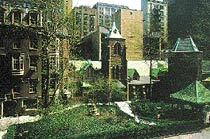
The Little Church & The Actors’ Guild
Over a century ago, there were prevailing feelings of prejudice against people in the theatre…an historical example: in 1870, Joseph Jefferson, the actor famous for his portrayal of Rip Van Winkle, had requested a funeral service at the Chur ch of the Atonement, then on Madison Avenue and 28th Street, for his friend and fellow actor George Holland (1791–1870), where Holland’s children were members of the Sunday School. The clergyman refused on learning that the funeral was for an actor. After some prodding by the stunned Jefferson, he suggested that “There is a little church around the corner where they did that kind of thing.” Jefferson responded, with all the dignity he could muster, “Then I say to you, Sir, God bless the little church around the corner.” And, indeed, the Rev. Dr. George H. Houghton, who had founded the “Little Church” at age 28, accepted the funeral without question.
ch of the Atonement, then on Madison Avenue and 28th Street, for his friend and fellow actor George Holland (1791–1870), where Holland’s children were members of the Sunday School. The clergyman refused on learning that the funeral was for an actor. After some prodding by the stunned Jefferson, he suggested that “There is a little church around the corner where they did that kind of thing.” Jefferson responded, with all the dignity he could muster, “Then I say to you, Sir, God bless the little church around the corner.” And, indeed, the Rev. Dr. George H. Houghton, who had founded the “Little Church” at age 28, accepted the funeral without question.
Across the country, newspapers of the day reported the incident, and even Mark Twain editorialized vehemently upon the matter.
For actors across America, the “Little Church” became a spiritual haven, and many leading members of the theatre community adopted it and began to worship there, including the great Edwin Booth, founder of The Players, whose own funeral service took place at the “Little Church” in 1893.
The Episcopal Actors’ Guild is the only surviving offspring of the Actors’ Church Alliance (ACA), an ecumenical organization founded in 1899 by Walter Bentley, who gave up his career as a young actor to become an Episcopal priest.
 The ACA, whose emblem was a Bible resting on a volume of Shakespeare, was Bentley’s effort to heal the rift between organized religion and the theatre.
The ACA, whose emblem was a Bible resting on a volume of Shakespeare, was Bentley’s effort to heal the rift between organized religion and the theatre.
In 1923 the ACA members and officers founded the inter-denominational Episcopal Actors’ Guild, encouraged by Father Bentley and welcomed by the Rev. Randolph Ray, D.D., the newly seated third Rector of “The Little Church Around the Corner,” officially The Church of the Transfiguration. Ray, who was a life-long devotee of the theatre, was pleased to offer the Guild its permanent headquarters, Guild Hall.
During the Roaring Twenties, the Guild served as a social and artistic center for its members while quietly assisting those in need. Among the first leaders of the Guild were many stars of the stage and silent movies, including George Arliss, as first President, Douglas Fairbanks, Mary Pickford and Julia Marlowe. After taking their bows on Broadway, performers would come to Guild Hall for late-night social gatherings.
During the early years, several future stars were helped at crucial times in their careers, and later generously remembered the Guild with contributions.
During the ’30s, ’40s, ’50s, and ’60s, the Guild continued its charitable programs and fellowship gatherings, and featured afternoon teas for its members. Annual fundraising Theatre Benefits at Broadway shows became an early tradition and were held by the Guild throughout this time.
The ’70s brought the Guild several major bequests, and the dedicated management of its growing endowment by the late Executive Secretary Lon Clark enabled the Guild to increase the scope of its activities steadily into the Eighties and Nineties.

